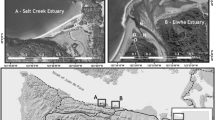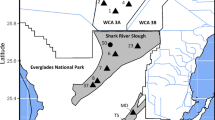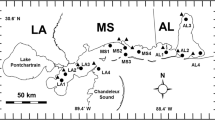Abstract
In the Mid-Atlantic, four species of forage fish, Menidia menidia (Atlantic Silverside), Fundulus heteroclitus (Mummichog), Fundulus majalis (Striped Killifish), and Cyprinodon variegatus (Sheepshead Minnow), account for a large proportion of fish abundance in estuarine environments and are important food sources for state and federally managed predatory species. The population dynamics of these species are poorly understood, and factors affecting their populations are largely unclear or unknown. Seine samples were collected in the Delaware Inland Bays over 9 years (2011–2019), with indices and trends in abundance, as well as climatic and biotic drivers of population changes investigated at both combined estuary and individual bay scales. Average interannual decreases in abundance for all four species at the combined estuary scale ranged between 31.9 and 69.2%, while increases ranged between 65.9 and 178.6%, indicating the extreme variability these species show between years. Standardized models of abundance demonstrated long-term declines in abundance for Mummichog and Sheepshead Minnow at both the combined estuary and individual bay scales. Spring discharge affected Mummichog and Sheepshead Minnow abundance, and Sheepshead Minnow showed a strong negative correlation with Summer Flounder abundance. These data quantify the variability in abundance for an important portion of the forage base in Mid-Atlantic estuaries and should be considered as fisheries management shifts away from single-species approaches and recognizes the forage needs of managed species. Results indicate that even commonly encountered species can consistently vary through time and emphasize the need to examine other important but poorly studied forage species.









Similar content being viewed by others
References
Able, K.W., J.H. Balletto, S.M. Hagan, P.R. Jivoff, and K. Strait. 2007a. Linkages between salt marshes and other nekton habitats in Delaware Bay, USA. Reviews in Fisheries Science 15: 1–61.
Able, K.W., S.M. Hagan, K. Kovitvongsa, S.A. Brown, and J.C. Lamonaca. 2007b. Piscivory by the mummichog Fundulus heteroclitus: Evidence from the laboratory and salt marshes. Journal of Experimental Marine Biology and Ecology 345: 26–37.
Able, K.W., and M.P. Fahay. 2010. Ecology of estuarine fishes temperate waters of the western Atlantic. Baltimore MD: The Johns Hopkins University Press.
Anderson, M.J. 2001. A new method for non-parametric multivariate analysis of variance. Austral Ecology 26: 32–46.
ASMFC. 2017. Atlantic Sturgeon benchmark stock assessment: Atlantic sturgeon stock assessment report, terms of reference and advisory report, and technical committee supplemental material. Washington (DC): ASMFC.
ASMFC. 2020. ASMFC Atlantic Menhaden Board Adopts Ecological Reference Points. Washington (DC): ASMFC.
Ball, J.R., D. Esler, and J.A. Schmutz. 2007. Proximate composition, energetic value, and relative abundance of prey fish from the inshore eastern Bering sea: Implications for piscivorous predators. Polar Biology 30: 699–708.
Balouskus, R.G., and T.E. Targett. 2016. Fish and Blue Crab density along a riprap-sill-hardened shoreline: Comparisons with Spartina marsh and riprap. Transactions of the American Fisheries Society 145: 766–773.
Bennett, W.A., and T.L. Beitinger. 1997. Temperature tolerance of the sheepshead minnow, Cyprinodon variegatus. Copeia 1: 77–87.
Boutin, B.P., and T.E. Targett. 2013. Fish and Blue Crab assemblages in the shore zone of tidal creeks in the Delaware Coastal Bays. Northeastern Naturalist 20: 69–90.
Boutin, B.P., and T.E. Targett. 2019. Density, growth, production, and feeding dynamics of juvenile Weakfish (Cynoscion regalis) in Delaware Bay and salt marsh tributaries; spatiotemporal comparison of nursery habitat quality. Estuaries and Coasts 42: 274–291.
Box, G.E.P., and G.M. Jenkins. 1976. Time series analysis: Forecasting and control. Revised. Oakland CA: Holden-Day.
Buchheister, A., and R.J. Latour. 2011. Trophic ecology of summer flounder in lower Chesapeake Bay inferred from stomach content and stable isotope analyses. Transactions of the American Fisheries Society 140: 1240–1254.
Buchheister, A., T.J. Miller, E.D. Houde, D.H. Secor, and R.J. Latour. 2016. Spatial and temporal dynamics of Atlantic Menhaden (Brevoortia tyrannus) recruitment in the Northwest Atlantic Ocean. ICES Journal of Marine Science 73: 1147–1159.
Buchheister, A., T.J. Miller, and E.D. Houde. 2017. Evaluating ecosystem-based reference points for Atlantic Menhaden. Marine and Coastal Fisheries 9: 457–478.
Burnham, K.P., and D.R. Anderson. 2002. Model selection and multimodel inference: A practical information-theoretic approach, 488. New York, NY: Springer.
Cernadas-Martin, S., K.J. Rountos, J.A. Nye, M.G. Frisk, and E.K. Pikitch. 2021. Composition and intraspecific variability in summer flounder (Paralichthys dentatus) diets in a eutrophic estuary. Frontiers in Marine Science 8: 1–15. https://doi.org/10.3389/fmars.2021.632751.
Clay, P.M., G. DePiper, S. Gaichas, J. Hare, E. Houde, and R. Seagraves. 2014. Managing forage fishes in the Mid-Atlantic region. A white paper to inform the Mid-Atlantic fishery management council. https://static1.squarespace.com/static/511cdc7fe4b00307a2628ac6/t/5c5c8f4f1905f47e33aa8307/1549569872867/MAFMC-Forage-White-Paper_Nov2014.pdf. Accessed 19 December 2019.
Conover, D.O., and M.R. Ross. 1982. Patterns in seasonal abundance, growth, and biomass of the Atlantic Silverside, Menidia menidia, in a New England estuary. Estuaries 4: 275–286.
Cury, P.M., I.L. Boyd, S. Bonhommeau, T. Anker-Nilssen, R.J.M. Crawford, R.W. Furness, J.A. Mills, E.J. Murphy, H. Osterblom, M. Paleczny, J.F. Piatt, J. Roux, L. Shannon, and W.J. Syderman. 2011. Global seabird response to forage fish depletion–one-third for the birds. Science 334: 1703–1706.
Deegan, L.A., J.E. Hughes, and R.A. Rountree. 2000. Salt marsh ecosystem support of marine transient species. In Concepts and controversies in tidal marsh ecology, ed. M.P. Weinstein and D.A. Kreeger, 333–365. Dordrecht: Kluwer Academic Publishers.
Dickey-Collas, M., G.H. Engelhard, A. Rindorf, K. Raab, S. Smout, G. Aarts, M. van Deurs, T. Brunel, A. Hoff, R.A.M. Lauerburg, S. Garthe, K. Haste Andersen, F. Scott, T. van Kooten, D. Beare, and M.A. Peck. 2014. Ecosystem-based management objectives for the North Sea: Riding the forage fish rollercoaster. ICES Journal of Marine Science 71: 128–142.
Drexler, M., and C.H. Ainsworth. 2013. Generalized additive models used to predict species abundance in the Gulf of Mexico: An ecosystem modeling tool. PLoS ONE. https://doi.org/10.1371/journal.pone.0064458.
Eero, M., M. Vinther, H. Haslob, B. Huwer, M. Casini, M. Storr-Paulsen, and F.W. Koster. 2012. Spatial management of marine resources can enhance the recovery of predators and avoid local depletion of forage fish. Conservation Letters 5: 486–492.
Enfield, D.B., A.M. Mestas-Nunez, and P.J. Trimble. 2001. The Atlantic multidecadal oscillation and its relation to rainfall and river flows in the continental U.S. Geophysical Research Letters 28: 2077–2080.
Engelhard, G.H., M.A. Peck, A. Rindorf, S.C. Smout, M. van Deurs, K. Raab, K.H. Andersen, S. Garthe, R.A.M. Lauerburg, F. Scott, T. Brunel, G. Aarts, T. van Kooten, and M. Dickey-Collas. 2014. Forage fish, their fisheries, and their predators: Who drives whom? ICES Journal of Marine Sciences 71: 90–104.
Essington, T.E., P.E. Moriarty, H.E. Froehlich, E.E. Hodgson, L.E. Koehn, K.L. Oken, M.C. Siple, and C.C. Stawitz. 2015. Fishing amplifies forage fish population collapses. PNAS 112: 6648–6652.
Friedland, K.D., G.C. Garman, A.J. Bejda, A.L. Studholme, and B. Olla. 1988. Interannual variation in diet and condition on juvenile Bluefish during estuarine residency. Transactions of the American Fisheries Society 117: 474–479.
Garcia-Rodriguez, F.J., and D. Aurioles-Gamboa. 2004. Spatial and temporal variation in the diet of California sea lion (Zalophus californianus) in the Gulf of California, Mexico. Fisheries Bulletin 102: 47–62.
Gobler, C.J., L.R. Merlo, B.K. Morrell, and A.W. Griffith. 2018. Temperature, acidification, and food supply interact to negatively affect the growth and survival of the forage fish, Menidia beryllina (inland silverside), and Cyprinodon variegatus (sheepshead minnow). Frontiers in Marine Science. https://doi.org/10.3389/fmars.2018.00086.
Grecay, P.A. 1990. Factors affecting spatial patterns of feeding success and condition of juvenile weakfish (Cynoscion regalis) in Delaware Bay: field and laboratory assessment. Doctoral Dissertation. University of Delaware, Lewes.
Hartman, K.J., and S.B. Brandt. 1995. Trophic resource partitioning, diets, and growth of sympatric estuarine predators. Transactions of the American Fisheries Society 124: 520–537.
Hastie, T., and R. Tibshirani. 1986. Generalized additive models. Statistical Science 1: 297–318.
Helser, T.E., and D.B. Hayes. 1995. Providing quantitative management advice from stock abundance indices based on research surveys. Fishery Bulletin 93: 290–298.
Hu, Q. S., S. Feng, and R. J. Oglesby. 2010. Variations in North American summer precipitation driven by the Atlantic multidecadal oscillation. Journal of Climate 24: 5555–5570. https://doi.org/10.1175/2011JCLI4060.1.
Hunter, K.L., M.G. Fox, and K.W. Able. 2009. Influence of flood frequency, temperature and population density on migration of Fundulus heteroclitus in semi-isolated marsh pond habitats. Marine Ecological Progress Series 391: 85–96.
Hurst, T.P., and D.O. Conover. 1996. Winter mortality of young-of-the-year Hudson River striped bass (Morone saxatilis): Size-dependent patterns and effects on recruitment. Canadian Journal of Fisheries and Aquatic Science 55: 1122–1130.
Ihde, T.F., E.D. Houde, C.F. Bonzek, and E. Franke. 2015. Assessing the Chesapeake Bay forage base: existing data and research priorities. STAC Publication Number 15–005. http://www.chesapeake.org/pubs/346_Ihde2015.pdf. Accessed 19 November 2019.
Jung, S., and E.D. Houde. 2004. Recruitment and spawning-stock biomass distribution of Bay Anchovy (Anchoa mitchilli) in Chesapeake Bay. Fisheries Bulletin 102: 63–77.
Kaplan, I.C., L.E. Koehn, E.E. Hodgson, K.N. Marshall, and T.E. Essington. 2017. Modeling food web effects of low sardine and anchovy abundance in the California current. Ecological Modelling 359: 1–24.
Kimmel, D.G., and M.R. Roman. 2004. Long-term trends in mesozooplankton abundance in Chesapeake Bay, USA: Influence of freshwater input. Marine Ecological Progress Series 267: 71–83.
Kneib, R.T. 1982. The effects of predation by wading birds (Ardeidae) and Blue Crabs (Callinectes sapidus) on the population size structure of the common Mummichog Fundulus heterclitus. Estuarine and Coastal Shelf Science 14: 159–166.
Kneib, R.T. 1986. The role of Fundulus heteroclitus in salt marsh trophic dynamics. American Zoology 26: 259–269.
Kornis, M.S., D. Breitburg, R. Balouskas, D.M. Bilkovic, L.A. Davias, S. Giordano, K. Heggie, A.H. Hines, J.M. Jacobs, T.E. Jordan, R.S. King, C.J. Patrick, R.D. Seitz, H. Soulen, T.E. Targett, D.E. Weller, D.F. Whigham, and J. Uphoff Jr. 2017. Linking the abundance of estuarine fish and crustaceans in nearshore waters to shoreline hardening and land cover. Estuaries and Coasts 40: 1464–1486.
Lindegren, M., C. Mollmann, A. Nielsen, and N.C. Stenseth. 2009. Preventing the collapse of the Baltic cod stock through and ecosystem-based management approach. PNAS 106: 14722–14727.
Lockfield, K.C., J.W. Fleeger, and L.A. Deegan. 2013. Mummichog Fundulus heteroclitus responses to long-term, whole ecosystem nutrient enrichment. Marine Ecological Progress Series 492: 211–222.
Martino, E.J., and E.D. Houde. 2010. Recruitment of striped bass in Chesapeake Bay: Spatial and temporal environmental variability and availability of zooplankton prey. Marine Ecological Progress Series 409: 213–228.
Mateo, I., and D.H. Hanselman. 2014. A comparison of statistical methods to standardize catch-per-unit-effort of the Alaska longline sablefish fishery. U.S. Dep. Commerce, NOAA Tech. Memo. NMFS-AFSC-269, 71 p.
Mathews, J.A., E.A. Hale, J.A. Clark, I.A. Park, M.J. Greco, C.J. Petrone, and H. Oleynik. 2022. Exploring trends in abundance of Atlantic croaker (Micropogonias undulatus), Black Drum (Pogonias cromis), Spot (Leiostomus xanthurus) and Weakfish (Cynoscion regalis) in relation to large scale climatic signals in a Mid-Atlantic estuary. Transactions of the American Fisheries Society. https://doi.org/10.1002/tafs.10332
McIvor, C.C., and W.E. Odum. 1988. Food, predation risk, and microhabiat selection in a marsh fish assemblage. Ecology 69: 1341–1351.
Meredith, W.H., and V.A. Lotrich. 1979. Production dynamics of a tidal creek population of Fundulus heteroclitus (Linnaeus). Estuarine and Coastal Marine Science 8: 99–118.
MAFMC. 2016. MAFMC Ecosystem approach to fisheries management guidance document. https://static1.squarespace.com/static/511cdc7fe4b00307a2628ac6/t/589a2b61d2b8575c64fe05ff/1486498674225/EAFM_Guidance+Doc_2017-02-07.pdf. Accessed 19 December 2019.
MAFMC. 2017. MAFMC Unmanaged forage omnibus amendment. https://static1.squarespace.com/static/511cdc7fe4b00307a2628ac6/t/5a0b49b053450ab00cbe4e46/1510689203283/20170613_Final%2BForage%2BEA_FONSI%2BSigned.pdf. Accessed 19 November 2019.
Myer, D.L., J.M. Johnson, and J.W. Gill. 2001. Comparison of nekton use of Phragmites autralis and Spartina alterniflora marshes in the Chesapeake Bay, USA. Marine Ecological Progress Series 209: 71–84.
NOAA. 2015. NOAA Fisheries economics of the United States, Mid-Atlantic region. https://www.st.nmfs.noaa.gov/Assets/economics/publications/FEUS/FEUS-2015/Report-Chapters/FEUS%202015%2007-MidAtlantic_Final3_508.pdf. Accessed on 20 December 2019.
Nelson, J.A., L. Deegan, and R. Garritt. 2015. Drivers of spatial and temporal variability in estuarine food webs. Marine Ecological Progress Series 533: 67–77.
Nelson, J.A., D.S. Johnson, L.A. Deegan, A.C. Spivak, and N.R. Sommer. 2018. Feedbacks between nutrient enrichment and geomorphology alter bottom-up control on food webs. Ecosystems. https://doi.org/10.1007/s10021-018-0265-x.
Nye, J.A., M.R. Baker, R. Bell, A. Kenny, K.H. Kilbourne, K.D. Friedland, E. Martino, M.M. Stachura, K.S. Van Houtan, and R. Wood. 2014. Ecosystem effects of the Atlantic multidecadal oscillation. Journal of Marine Systems 133: 103–116.
Oghenekaro, E.U., and P. Chigbu. 2019. Dynamics of mesozooplankton assemblage in relation to environmental factors in the Maryland Coastal Bays. Water 11: 1–21. https://doi.org/10.3390/w11102133.
Overton, A.S., C.S. Manooch III., J.W. Smith, and K. Brennan. 2008. Interactions between adult migratory striped bass (Morone saxatilis) and their prey during winter off the Virginia and North Carolina Atlantic coast from 1994 through 2007. Fisheries Bulletin 106: 174–182.
Pennington, M. 1986. Some statistical techniques for estimating abundance indices from trawl surveys. Fishery Bulletin 84: 519–525.
Pikitch, E.K., K.J. Rountos, T.E. Essington, C. Santora, D. Pauly, R. Watson, U.R. Sumaila, P.D. Boersma, I.L. Boyd, D.O. Conover, P. Cury, S.S. Heppell, E.D. Houde, M. Mangel, E. Plaganyi, K. Sainsbury, R.S. Steneck, T.M. Geers, N. Gownaris, and S.B. Munch. 2012. The global contribution of forage fish to marine fisheries and ecosystems. Fish and Fisheries 15: 43–64. https://doi.org/10.1111/faf.12004.
Raposa, K. 2003. Overwintering habitat selection by the Mummichog, Fundulus heteroclitus, in a Cape Cod (USA) salt marsh. Wetlands Ecology and Management 11: 175–182.
Reum, J.C.P., T.E. Essington, C.M. Greene, C.A. Rice, and K.L. Fresh. 2011. Multiscale influence of climate on estuarine populations of forage fish: The role of coastal upwelling, freshwater flow and temperature. Marine Ecological Progress Series 425: 203–215.
Roundtree, R.A., and K.W. Able. 1992. Foraging habits, growth, and temporal patterns of salt-marsh creek habitat use by young-of-year summer flounder in New Jersey. Transactions of the American Fisheries Society 121: 765–776.
Scharf, F.S., J.P. Manderson, M.C. Fabrizio, J.P. Pessutti, J.E. Rosendale, R.J. Chant, and A.J. Bejda. 2004. Seasonal and interannual patterns of distribution and diet of Bluefish within a Middle Atlantic Bight estuary in relation to abiotic and biotic factors. Estuaries 27: 426–436.
Schultz, E.T., D.O. Conover, and A. Ehtisham. 1997. The dead of winter: Size-dependent variation and genetic differences in seasonal mortality among Atlantic silverside (Atherinidae: Menidia menidia) from different latitudes. Canadian Journal of Fisheries and Aquatic Sciences 55: 1149–1157.
Smith, L.A., J.S. Link, S.X. Cadrin, and D.L. Palka. 2015. Consumption by marine mammals on the Northeast U.S. continental shelf. Ecological Applications 25: 373–389.
SEDAR. 2015. SEDAR 40 Atlantic menhaden stock assessment report. SEDAR, North Charleston SC. http://www.sefsc.noaa.gov/sedar/Sedar_Workshops.jsp?WorkshopNum=40. Accessed 3 December 2019.
Stevens, P.W., C.L. Montague, and K.J. Sulak. 2006. Fate of fish production in a seasonally flooded saltmarsh. Marine Ecological Progress Series 327: 267–277.
Taylor, D.L., K.J. Cribari, and A. Scro. 2019. Piscivory in age-0 Summer Flounder Paralicthys dentatus with a focus on predator-induced mortality of post-settlement winter flounder Pseudopleuronectes americanus. Marine Ecological Progress Series 612: 7–28.
Thompson, J.S. 2015. Size-selective foraging of adult mummichogs, Fundulus heteroclitus, in intertidal and subtidal habitats. Estuaries and Coasts 38: 1535–1544.
Torre, M.P., and T.E. Targett. 2017. Feeding by bluefish and weakfish along riprap-hardened shorelines: Comparisons with adjacent sandy beach in Delaware Bay, USA. Transactions of the American Fisheries Society 146: 341–348.
Townsend, H., C.J. Harvey, Y. deReynier, D. Davis, S.G. Zador, S. Gaichas, M. Weijerman, E.L. Hazen, and I.C. Kaplan. 2019. Progress implementing ecosystem-based fisheries management in the United States through the use of ecosystem models and analysis. Frontiers in Marine Science. https://doi.org/10.3389/fmars.2019.00641.
Tupper, M., and K.W. Able. 2000. Movements and food habits of striped bass (Morone saxatilis) in Delaware Bay (USA) salt marshes: Comparison of a restored and reference marsh. Marine Biology 137: 1049–1058.
Wagner, C.M., and H.M. Austin. 1999. Correspondence between environmental gradients and summer littoral fish assemblages in low salinity reaches of the Chesapeake Bay, USA. Marine Ecological Progress Series 177: 197–212.
Walch, M., E. Seldomridge, A. McGowan, S. Boswell, and C. Bason. 2016. 2016 State of the Delaware Inland Bays. Rehoboth Beach DE. https://www.inlandbays.org/wp-content/uploads/Final-CIB-State-of-the-Bays-2016-low-res.pdf. Accessed 13 August 2021.
Weisberg, S.B., and V.A. Lotrich. 1986. Food limitation of a Delaware salt marsh population of the mummichog, Fundulus heteroclitus (L.). Oecologia 68: 168–173.
Wieski, K., and S.C. Pennings. 2013. Climate drivers of Spartina alterniflora saltmarsh production in Georgia. USA: Ecosystems. https://doi.org/10.1007/s10021-013-9732-6.
Woodland, R.J., A. Buchheister, R.J. Latour, C. Lozano, E. Houde, C.J. Sweetman, M.C. Fabrizio, and T.D. Tuckey. 2021. Environmental drivers of forage fishes and benthic invertebrates at multiple spatial scales in a large temperate estuary. Estuaries and Coasts 44: 921–938.
Ziegler, S.L., K.W. Able, and F.J. Fodrie. 2019. Dietary shifts across biogeographic scales alter spatial subsidy dynamics. Ecosphere 10: 1–13. https://doi.org/10.1002/ecs2.2980.
Acknowledgements
This work would not have been possible without the amazing group of volunteers who have collected the data used in this study. Particular thanks must be given to the late Ron Kernehan for starting this survey. Thank you to Dr. Marianne Walch, John Clark, and Roy Miller for their oversight and advice with the survey.
Funding
This work was funded by the US Environmental Protection Agency (cooperative agreements EPA—CE-993990–10, -11, -12, -13, -14, -15) and by grants from the State of Delaware, Department of Natural Resources and Environmental Control.
Author information
Authors and Affiliations
Corresponding author
Ethics declarations
Conflict of Interest
The Delaware Center for the Inland Bays is a non-profit organization and a National Estuary Program. It was created to promote the wise use and enhancement of the Inland Bays watershed by conducting public outreach and education, developing and implementing restoration projects, encouraging scientific inquiry and sponsoring needed research, and establishing a long-term process for the protection and preservation of the Inland Bays watershed. The authors declare that they have no conflict of interest.
Additional information
Communicated by Mark S. Peterson
Rights and permissions
About this article
Cite this article
McGowan, A.T., Hale, E.A., Bartow, D.H. et al. Population Dynamics of Common Nearshore Forage Fishes in the Delaware Inland Bays, USA. Estuaries and Coasts 45, 2181–2203 (2022). https://doi.org/10.1007/s12237-022-01066-w
Received:
Revised:
Accepted:
Published:
Issue Date:
DOI: https://doi.org/10.1007/s12237-022-01066-w




